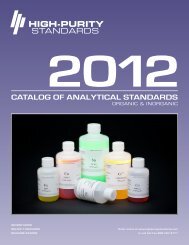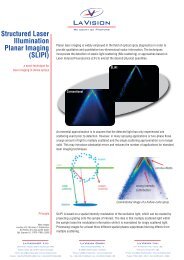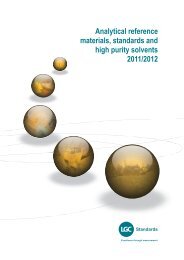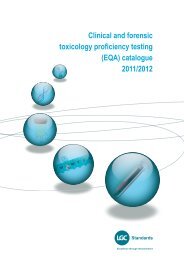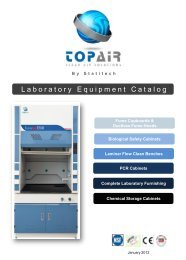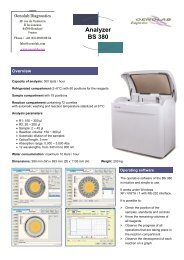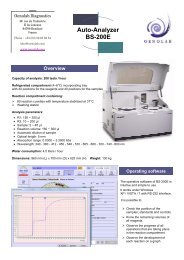Proficiency testing catalogue - LGC Standards
Proficiency testing catalogue - LGC Standards
Proficiency testing catalogue - LGC Standards
Create successful ePaper yourself
Turn your PDF publications into a flip-book with our unique Google optimized e-Paper software.
Frequently askedquestionsFurther information on approaches toevaluating measurement uncertainty mayalso be available from your nationalaccreditation body. For example, UKASM3003 "The expression of uncertainty andconfidence in measurement".The EURACHEM/CITAC Guide can bedownloaded, along with further informationon evaluating measurement uncertainty,from the website www.nmschembio.org.ukQ: Can I use PT data to estimate mymeasurement uncertainty?A: It is possible, but must be regarded as avery rough estimate, and is not an approachaddressed in many guides to evaluatingmeasurement uncertainty. However, twodocuments that do address the use of PTdata are:- NORDTEST Report TR 537 "Handbook forCalculation of Measurement Uncertainty inEnvironmental Laboratories"- ISO/TS 19036 "Microbiology of food andanimal feeding stuffs - Guidelines for theestimation of measurement uncertainty forquantitative determinations"Q: What is the standard deviation forproficiency assessment (SDPA)?A: The SDPA expresses the acceptabledifference between the laboratory result andthe assigned value. An acceptable z-scorerepresents a result that does not deviatefrom the assigned value by more than twicethe SDPA. The method used to determinethe SDPA may vary depending upon theparticular scheme and test material and isdetailed in the relevant scheme description.Q: What standard deviation for proficiencyassessment (SDPA) is used inmicrobiology PT schemes?A: There are many sources of variation inmicrobiological <strong>testing</strong> and the SDPA used toassess performance therefore needs to befit-for-purpose and take all possible sourcesof variation into account. From experienceand historical data, <strong>LGC</strong> <strong>Standards</strong> PT usesa fixed SDPA value of 0.35 log 10 for themajority of microbiological tests.Q: What is the purpose of scoring my result?A: Once the assigned value for the parametersunder test has been established, participantlaboratories are assessed on the differencebetween their result and the assigned value,with this difference being represented by aperformance score called a z-score. Thisprovides a simple and consistent measureof performance which is the key tomonitoring competence and implementingan improvement programme as required.Q: How are z-scores calculated?A: The participant’s result, x, is converted intoa z-score using the following formula;z = (x - X)SDPAWhere: X = the assigned value SDPA =standard deviation for proficiency assessment.For small data sets, there will be increaseduncertainty around the assigned value ifusing consensus values from participants’results. In such cases, z-scores may not beprovided, or may be given for informationonly.The z-score expresses performance inrelation to the assigned value and standarddeviation. A z-score of 2 represents a resultthat is a distance of 2 x SDPA from theassigned value.A fixed value for SDPA is preferable as thisenables z-scores to be compared from roundto round to demonstrate general trends.For each scheme, the value of SDPA andthe method used to derive it is reported inthe scheme description and/or report.58 Tel: +44 (0)161 762 2500 Fax: +44 (0)161 762 2501



